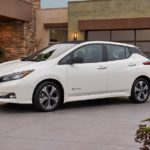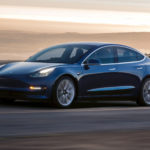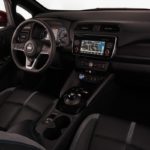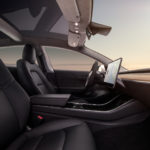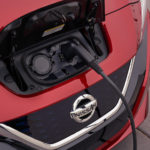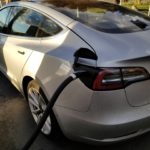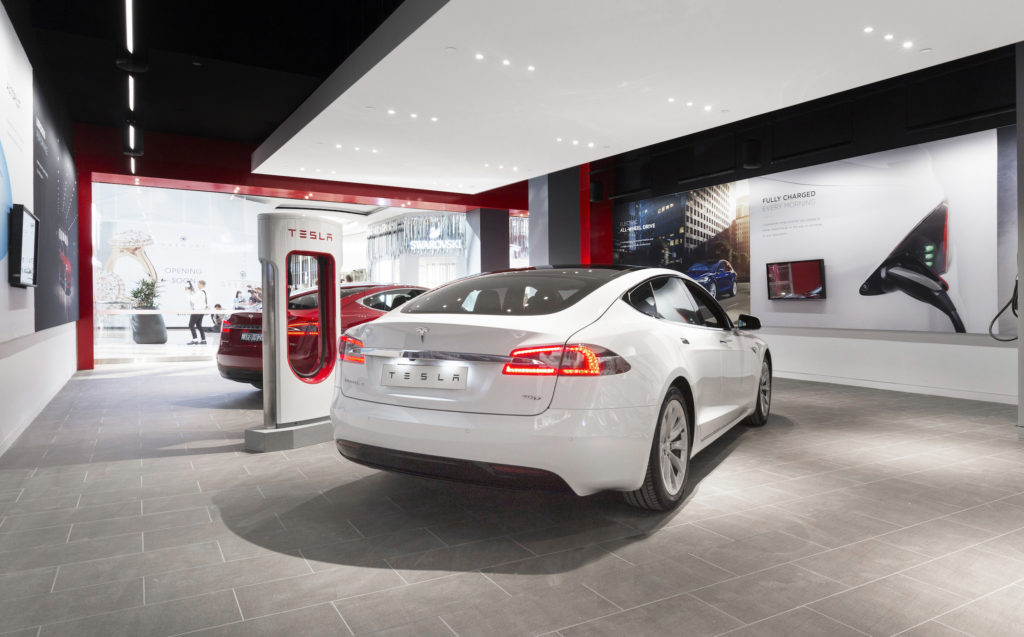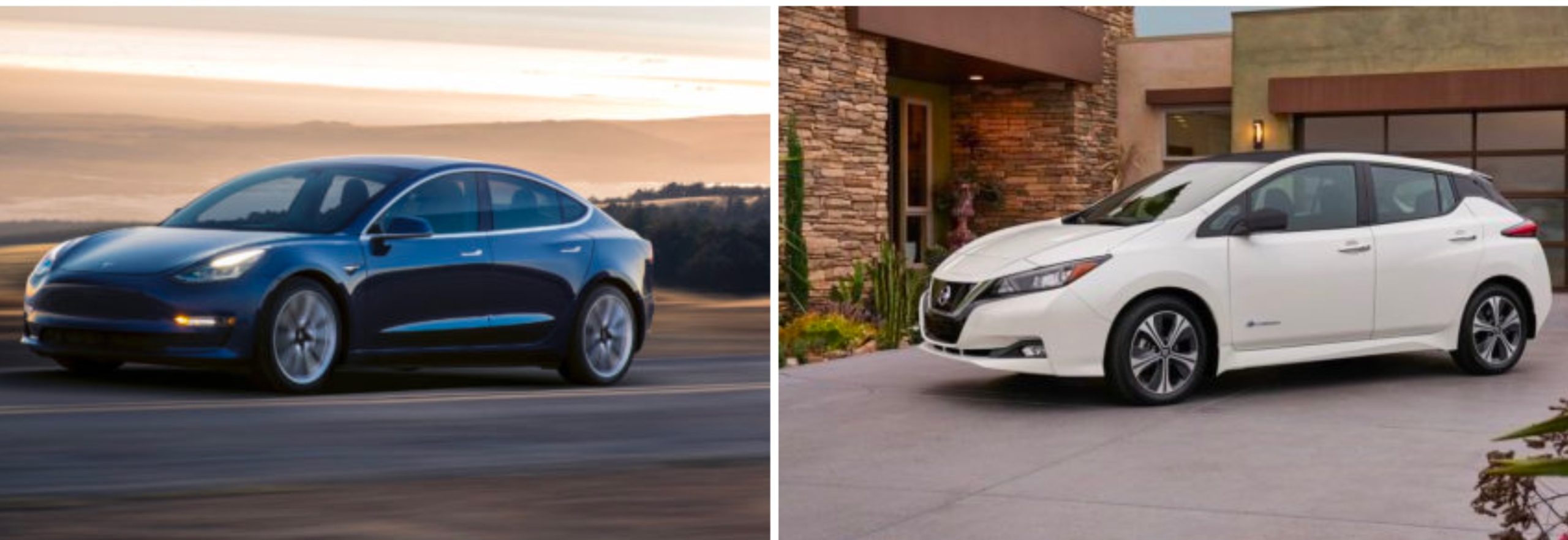
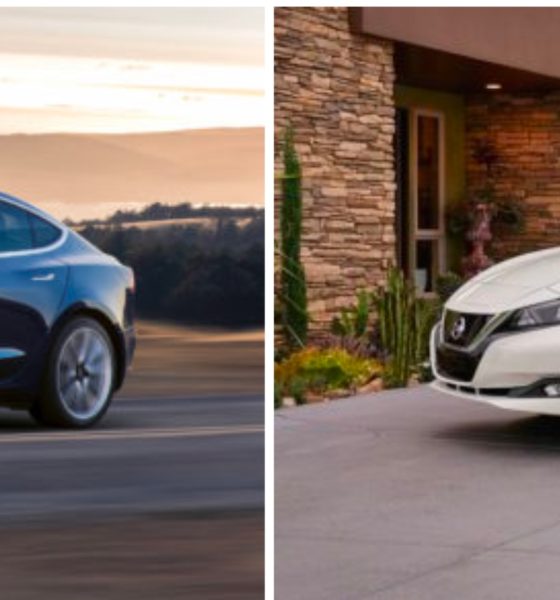
News
Tesla Model 3 vs 2018 Nissan Leaf – A side by side comparison
Tesla’s mission is simple and includes getting other automakers to join in the party. The Chevy Bolt, quirky as it may look, technically beat Tesla to market with a 200+ mile range EV that can be had for the $35,000 ballpark. Nissan, who I humbly believe to be the only other automaker currently taking full EVs seriously, has just announced their all new 2018 Leaf. The party is undoubtedly slow, but other automakers such as Volvo have at least talked about “electrification” (clever marketing shorthand for hybrids) but we can no longer deny that electric vehicles are here and their growth will not be able to be stopped.
Just as every concept EV talked about before 2016 was touted as a “Tesla killer,” it is now impossible not to compare every new electric offering with the much anticipated Tesla Model 3. So let’s do just that. The table below highlights some key specs for each.
| NISSAN LEAF | TESLA MODEL 3 | |
| Base price, before tax credits | $29,990 | $35,000 |
| Price with options | SL – $36,200 | Premium + EAP – $45,000 |
| Range (miles) | 150 (higher coming 2019) | 220 (310 for $9,000 upgrade) |
| Battery | 40 kWh/ (higher coming 2019) | Undisclosed |
| Charge time – Level 2 | Up to 22 miles per hour | Up to 30 miles per hour (std batt) |
| Charge time – Level 3 | Up to 88 miles per ½ hour | Up to 130 miles per ½ hour (std) |
| Charging network | No dedicated network | Tesla Supercharger, pay per use |
| Overall Length/Width | 176.4” / 70.5” | 184.8” / 82.2” |
| Cargo space | 23.6 cf | 15 cf |
| Body style | 4-door hatchback | 4-door sedan |
| Infotainment | Apple CarPlay, Android Auto | Tesla’s own |
| Main display | 7” | 15” |
| 0-60 mph time | 8 seconds (Motor Trend est.) | 5.6 seconds |
| Driver’s Assist Suite | ProPILOT ($2,200) | Autopilot ($5,000) |
| Automatic Emergency Braking | Standard | Standard |
If you want to get into a relatively long range EV (150 miles or greater) for the lowest possible price, the base 2018 Nissan Leaf wins out. I will also assume that you will be able to get your hands on a Leaf much sooner than a Model 3. Finally, if you absolutely insist on a hatchback, the Leaf has it.
Outside of those three things, and possibly the still large size of a Model 3, I can’t personally find any reason to choose a Leaf over a Model 3. To be clear I’m proud of Nissan for upping their game a bit. The 2018 version is in my very humble opinion, far superior in the looks department to the frog-like 2017 it is replacing. Nissan’s V-Motion grille is sharp, and hopefully takes your attention off the obvious charge port cover above it. The lines of the car itself are much more closely aligned with Nissan’s other offerings, which I find to have adequate design. Similarly, the rear tail lights are modern and edgy. If you can excuse all the buttons, the interior looks sharp. The Apple and Android faithful alike will appreciate the available car play integration. The bottom line for me is that every EV is a step in the right direction, even if this car won’t compel families to ditch the gasoline completely. In the absence of a reliable and dedicated fast charging network for long distance travel, the Leaf is still primarily a commuter car. 150 miles of range will simply allow a few after work activities without much thought.
I am excited to see the range and price that Nissan makes available in 2019 because for now, the base cost per mile of $199.93 falls far short of Tesla’s $159.09. I’d also like to see them re-think their battery management system, which I am to understand leaves something to be desired. One owner described his experience with a 2014 Leaf as losing 20% capacity thus far.
When looking at what we know about the Model 3 however, I can’t really compare the Leaf in any serious manner. I’m trying to be reasonable, to give Nissan a fair shake, but there are several things that make me a Tesla fanatic that are sorely missing from the Leaf – and any other current EV for that matter – that may or may not ever come close.
Supercharging. EVs will remain a commuter or secondary car until you can load up the kids and head to Disney with the reasonable assurance that there are plenty of chargers along the way that will a) be working, and b) charge quickly. Tesla has made a huge commitment in this front because they know that’s what it takes.
Over the air updates. I have not yet heard of Nissan taking this approach, but I suspect if they do, it would be limited to maps and small changes. I don’t foresee the Leaf being able to give your car the sudden ability to automatically open your garage four years after you’ve purchased it. Some current automakers do have software updates for their vehicles, but my understanding is that you have to bring it in to the dealership to have it done. This totally defeats the purpose.
Dealerships. You’d be hard pressed to find a harsher critic of dealerships than I. Whether discussing the 2011 Jeep Wrangler that took me 3 hours to get for the exact price I walked in and demanded, or that time I spoke on behalf of a recently widowed neighbor with an actual cash budget who could not, no matter how you pitch it, afford that extended dealer’s warranty package, I can go on and on and about how much I dislike the experience. It always takes hours. You always get passed around from salesperson to manager to finance person. You may even get your credit run 10 times simultaneously (I’m talking to you, Hyundai dealership!) No thank you. I will order my car online, know the exact price and meet you there with a pre-printed check for the exact amount owed.
Looks. I get it, I really do, people love hatchbacks. My Model S is a hatch and has accommodated many a Home Depot trip. My once beloved Scion tC was a hatch, and once hauled 27 boxes of Pergo brand laminate floor planks. Even the Jeep with the horrible dealership experience picked up a washing machine. A washing machine! But I simply cannot wrap my head around the idea that you could conceivably compare the gorgeous, timeless and sleek looks of the Model 3 with the quirky, if a bit modern and sharp, Nissan Leaf.
Performance. There’s a reason I never considered a hybrid or EV before. Now that I’m a bit older and have the budget to pick a car I actually like, I’m not going to voluntarily drive something that takes 8 seconds to get to 60. I want tight steering, good handling, and the ability to make my passengers squeal with delight when I punch it.
Interior. This is a personal preference and I’m with you if you think the minimalistic interior of the Model 3 is crazy. It is. But I can just about promise you that you will not miss all those buttons. I sat in a Porsche Macan at the auto show and while I expected to feel great inside a new offering from a brand with as much clout as Porsche, I was too busy wondering what in the world all those buttons did. It’s almost a joke how many.
Confession: I started this post excited about the new Leaf. I tweeted about it first thing this morning; the more the merrier in EV world if you ask me. But when getting right down to the specifications, it’s hard not to see that everyone else still has a long way to go. They’re taking baby steps while Tesla is competing in the long jump.
What do you think? Do the two cars compare? Tell us in the comments!

Investor's Corner
SpaceX IPO is coming, CEO Elon Musk confirms
However, it appears Musk is ready for SpaceX to go public, as Ars Technica Senior Space Editor Eric Berger wrote an op-ed that indicated he thought SpaceX would go public soon. Musk replied, basically confirming it.

Elon Musk confirmed through a post on X that a SpaceX initial public offering (IPO) is on the way after hinting at it several times earlier this year.
It also comes one day after Bloomberg reported that SpaceX was aiming for a valuation of $1.5 trillion, adding that it wanted to raise $30 billion.
Musk has been transparent for most of the year that he wanted to try to figure out a way to get Tesla shareholders to invest in SpaceX, giving them access to the stock.
He has also recognized the issues of having a public stock, like litigation exposure, quarterly reporting pressures, and other inconveniences.
However, it appears Musk is ready for SpaceX to go public, as Ars Technica Senior Space Editor Eric Berger wrote an op-ed that indicated he thought SpaceX would go public soon.
Musk replied, basically confirming it:
As usual, Eric is accurate
— Elon Musk (@elonmusk) December 10, 2025
Berger believes the IPO would help support the need for $30 billion or more in capital needed to fund AI integration projects, such as space-based data centers and lunar satellite factories. Musk confirmed recently that SpaceX “will be doing” data centers in orbit.
AI appears to be a “key part” of SpaceX getting to Musk, Berger also wrote. When writing about whether or not Optimus is a viable project and product for the company, he says that none of that matters. Musk thinks it is, and that’s all that matters.
It seems like Musk has certainly mulled something this big for a very long time, and the idea of taking SpaceX public is not just likely; it is necessary for the company to get to Mars.
The details of when SpaceX will finally hit that public status are not known. Many of the reports that came out over the past few days indicate it would happen in 2026, so sooner rather than later.
But there are a lot of things on Musk’s plate early next year, especially with Cybercab production, the potential launch of Unsupervised Full Self-Driving, and the Roadster unveiling, all planned for Q1.
News
Tesla adds 15th automaker to Supercharger access in 2025
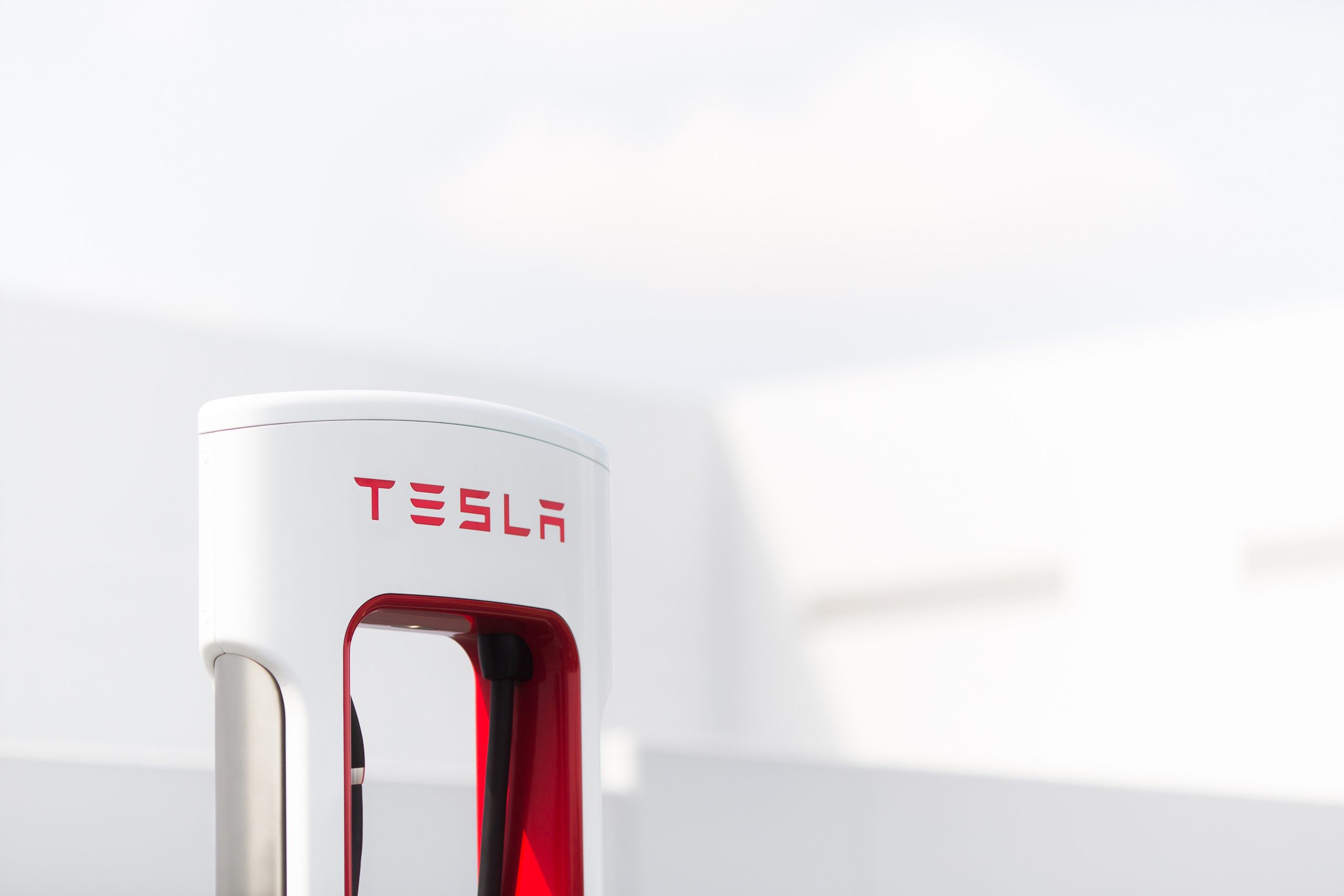
Tesla has added the 15th automaker to the growing list of companies whose EVs can utilize the Supercharger Network this year, as BMW is the latest company to gain access to the largest charging infrastructure in the world.
BMW became the 15th company in 2025 to gain Tesla Supercharger access, after the company confirmed to its EV owners that they could use any of the more than 25,000 Supercharging stalls in North America.
Welcome @BMW owners.
Download the Tesla app to charge → https://t.co/vnu0NHA7Ab
— Tesla Charging (@TeslaCharging) December 10, 2025
Newer BMW all-electric cars, like the i4, i5, i7, and iX, are able to utilize Tesla’s V3 and V4 Superchargers. These are the exact model years, via the BMW Blog:
- i4: 2022-2026 model years
- i5: 2024-2025 model years
- 2026 i5 (eDrive40 and xDrive40) after software update in Spring 2026
- i7: 2023-2026 model years
- iX: 2022-2025 model years
- 2026 iX (all versions) after software update in Spring 2026
With the expansion of the companies that gained access in 2025 to the Tesla Supercharger Network, a vast majority of non-Tesla EVs are able to use the charging stalls to gain range in their cars.
So far in 2025, Tesla has enabled Supercharger access to:
- Audi
- BMW
- Genesis
- Honda
- Hyundai
- Jaguar Land Rover
- Kia
- Lucid
- Mercedes-Benz
- Nissan
- Polestar
- Subaru
- Toyota
- Volkswagen
- Volvo
Drivers with BMW EVs who wish to charge at Tesla Superchargers must use an NACS-to-CCS1 adapter. In Q2 2026, BMW plans to release its official adapter, but there are third-party options available in the meantime.
They will also have to use the Tesla App to enable Supercharging access to determine rates and availability. It is a relatively seamless process.
News
Tesla adds new feature that will be great for crowded parking situations
This is the most recent iteration of the app and was priming owners for the slowly-released Holiday Update.
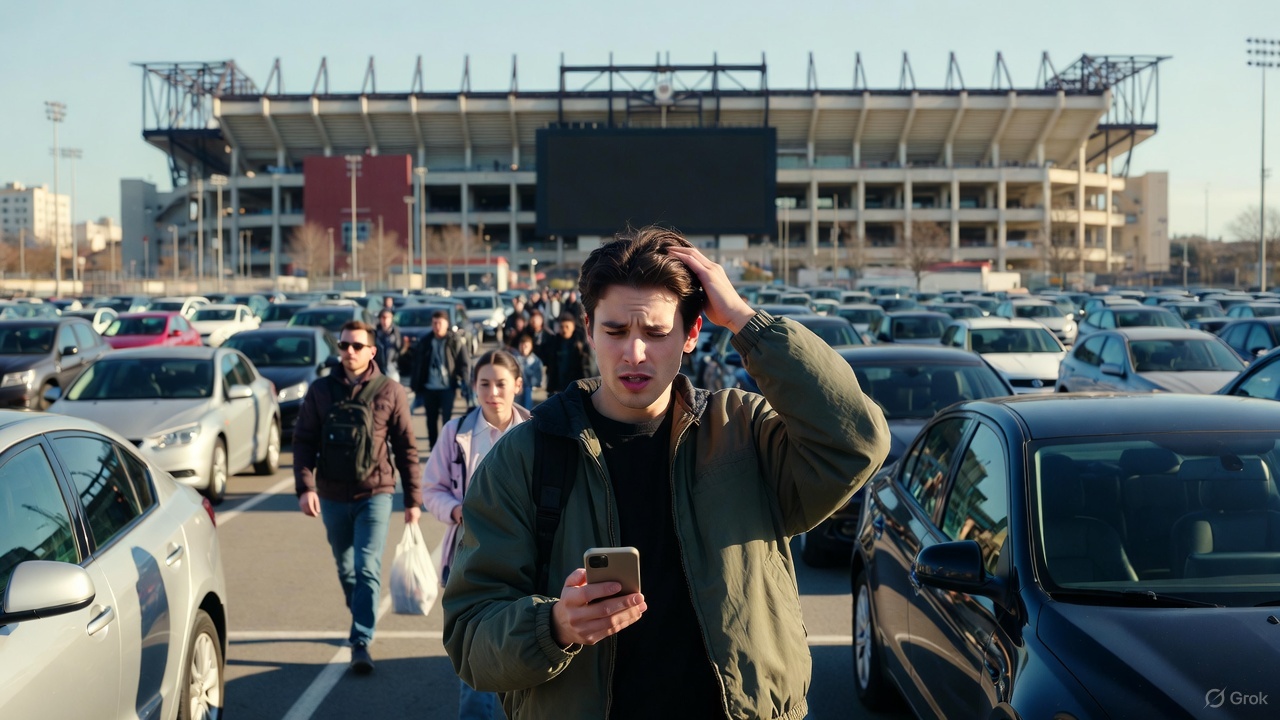
Tesla has added a new feature that will be great for crowded parking lots, congested parking garages, or other confusing times when you cannot seem to pinpoint where your car went.
Tesla has added a new Vehicle Locator feature to the Tesla App with App Update v4.51.5.
This is the most recent iteration of the app and was priming owners for the slowly-released Holiday Update.
While there are several new features, which we will reveal later in this article, perhaps one of the coolest is that of the Vehicle Locator, which will now point you in the direction of your car using a directional arrow on the home screen. This is similar to what Apple uses to find devices:
Interesting. The location arrow in the Tesla app now points to your car when you’re nearby. pic.twitter.com/b0yjmwwzxN
— Whole Mars Catalog (@wholemars) December 7, 2025
In real time, the arrow gives an accurate depiction of which direction you should walk in to find your car. This seems extremely helpful in large parking lots or unfamiliar shopping centers.
Getting to your car after a sporting event is an event all in itself; this feature will undoubtedly help with it:
The nice little touch that Tesla have put in the app – continuous tracking of your vehicle location relative to you.
There’s people reporting dizziness testing this.
To those I say… try spinning your phone instead. 😉 pic.twitter.com/BAYmJ3mzzD
— Some UK Tesla Guy (UnSupervised…) (@SomeUKTeslaGuy) December 8, 2025
Tesla’s previous app versions revealed the address at which you could locate your car, which was great if you parked on the street in a city setting. It was also possible to use the map within the app to locate your car.
However, this new feature gives a more definitive location for your car and helps with the navigation to it, instead of potentially walking randomly.
It also reveals the distance you are from your car, which is a big plus.
Along with this new addition, Tesla added Photobooth features, Dog Mode Live Activity, Custom Wraps and Tints for Colorizer, and Dashcam Clip details.
🚨 Tesla App v4.51.5 looks to be preparing for the Holiday Update pic.twitter.com/ztts8poV82
— TESLARATI (@Teslarati) December 8, 2025
All in all, this App update was pretty robust.
